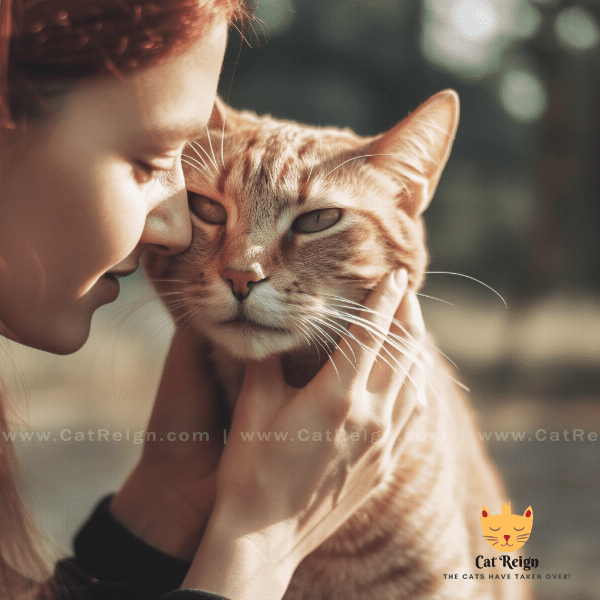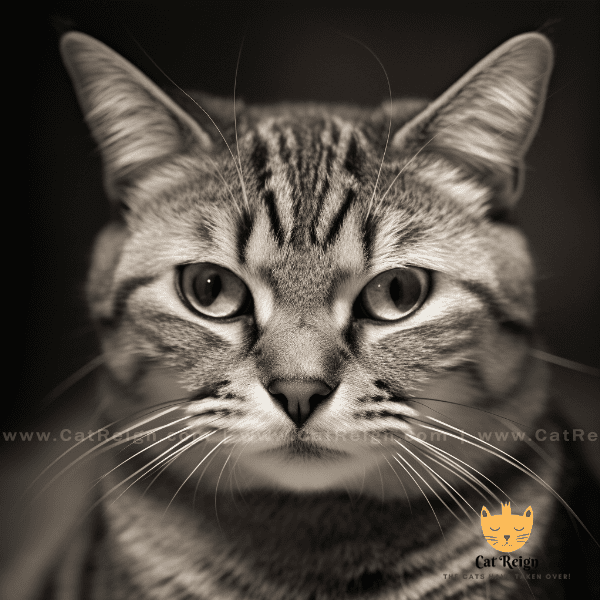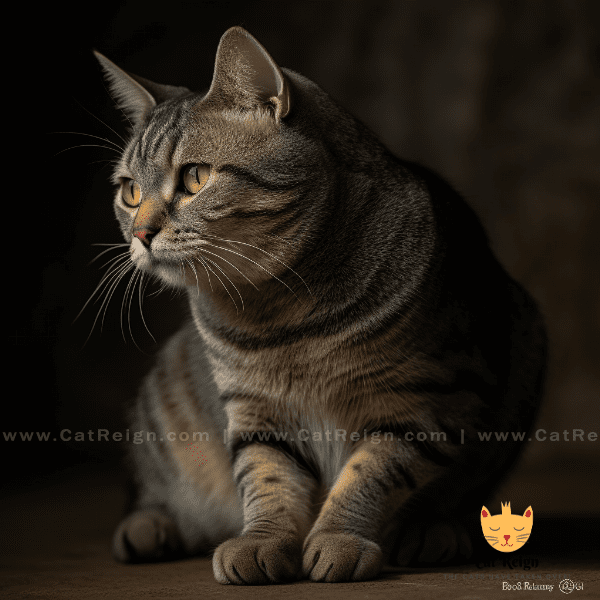Table of Contents
- Introduction to Feline Communication
- Understanding Cat Body Language
- Deciphering Tail Movements in Cats
- Interpreting Ear Positions and Expressions
- Reading Facial Expressions in Cats
- Vocalizations and What They Mean
- Communicating with Your Cat Using Body Language
- Misunderstandings and Common Cat Communication Errors
- Tips for Strengthening Your Bond with Your Cat
- Conclusion: Enhancing Communication with Your Feline Friend
Introduction to Feline Communication
Cats are fascinating creatures with their own unique ways of communicating. Understanding Cat body language is crucial in building a strong bond with your feline friend. In this section, we’ll delve into the various modes of communication that cats use to convey their thoughts and feelings.
Why is Understanding Feline Communication Important?
Cats are non-verbal creatures, which means that they rely heavily on body language to express themselves. By paying attention to your cat’s body language and vocalizations, you can gain valuable insight into their needs and emotions. This, in turn, can help you provide them with the appropriate care and attention they need.
How Do Cats Communicate with Body Language?
Cats use a variety of body postures, movements, and vocalizations to communicate with each other and with humans. Some common forms of feline communication include tail movements, ear positions, facial expressions, and vocalizations. By learning how to interpret these signals, you can better understand what your cat is trying to tell you.
The Benefits of Understanding Feline Communication
Being able to communicate effectively with your cat has many benefits. For one, it can help you identify and address any health or behavioral issues they may be experiencing. Additionally, it can help you establish a strong bond with your cat based on mutual understanding and trust.
Understanding feline communication can also help you prevent misunderstandings and conflicts with your cat. For example, if your cat is displaying aggressive behavior, it may be a sign that they are feeling threatened or stressed. By recognizing these signals early on, you can take steps to address the underlying issue and prevent any further escalation.
In the next sections, we’ll explore the different ways cats communicate through their body language and vocalizations. By the end of this guide, you’ll have a better understanding of your feline friend’s unique ways of communicating and how to respond appropriately.

Understanding Cat Body Language
Cat body language is complex and nuanced, but by paying attention to a few key signals, you can start to decipher what your cat is trying to tell you. In this section, we’ll explore the different parts of a cat’s body that they use to communicate.
Tail Movements
A cat’s tail is perhaps one of the most expressive parts of their body. A twitchy, puffed-up tail may indicate fear or aggression, while a slowly swishing tail may indicate that your cat is feeling content. A tail tucked between the legs is often a sign of fear or submission.
Ear Positions
Cats use their ears to communicate a range of emotions. If your cat’s ears are pointed forward, they may be feeling curious or alert. If their ears are flattened against their head, it may be a sign that they are feeling scared or defensive.
Facial Expressions
A cat’s facial expressions can also give you valuable clues as to how they are feeling. For example, if your cat is squinting or has relaxed eyes, it may indicate that they are feeling calm and content. Conversely, dilated pupils or a tense expression may indicate fear or aggression.
Vocalizations
Cats are known for their vocalizations, and they can use them to communicate a range of emotions. A soft purr often indicates contentment, while a loud meow may indicate hunger or a desire for attention. Hissing or growling may be a sign of fear or aggression.
By paying attention to these different aspects of your cat’s body language, you can begin to understand what they are trying to tell you. In the next sections, we’ll dive deeper into each of these forms of communication to help you better understand your feline friend.
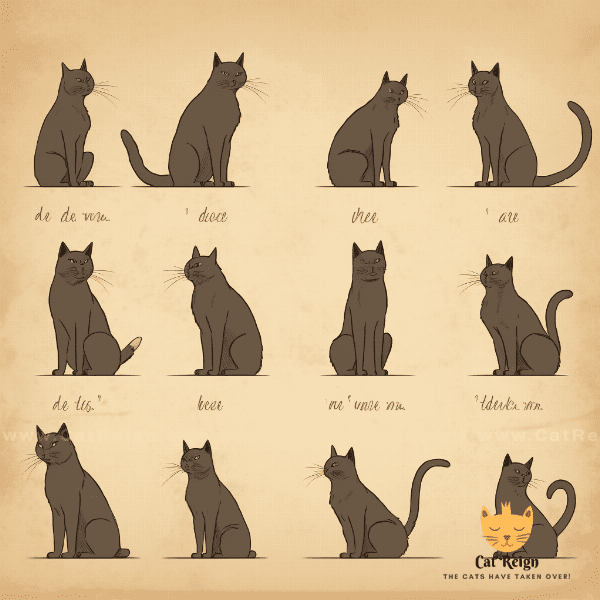
Deciphering Tail Movements in Cats
As mentioned earlier, a cat’s tail is a crucial part of their communication arsenal. In this section, we’ll explore some of the different tail movements that cats use to express themselves.
Tail Position
The position of a cat’s tail can tell you a lot about their mood. A high, upright tail often indicates that a cat is feeling confident and content. A tail held low or tucked between the legs may indicate fear or anxiety.
Twitching Tail
A twitching tail can be a sign of agitation or irritation. If your cat’s tail is twitching rapidly, it may be a sign that they are feeling annoyed or angry. Conversely, a slow, deliberate tail movement may indicate that your cat is feeling relaxed and content.
Puffed-Up Tail
If your cat’s tail is puffed up, it may be a sign of fear or aggression. When a cat feels threatened, they may puff up their tail in an attempt to make themselves appear larger and more intimidating.
Wrapping Tail
Some cats may wrap their tail around their body as a sign of comfort or contentment. This is often seen in cats who are feeling relaxed and at ease in their environment.
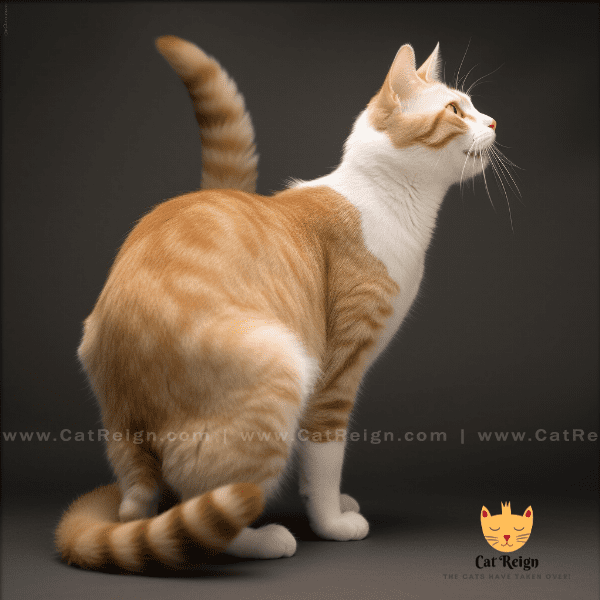
Interpreting Ear Positions and Expressions
Forward-Pointing Ears
When a cat’s ears are pointed forward, it often indicates that they are feeling alert and curious. This is a common position for a cat’s ears when they are exploring a new environment or investigating a new object.
Flattened Ears
Flattened ears can be a sign of fear, aggression, or discomfort. If your cat’s ears are flat against their head, it may be a sign that they are feeling threatened or defensive.
Sideways Ears
Sideways ears can be a sign of uncertainty or apprehension. If your cat’s ears are positioned to the side, it may indicate that they are unsure of their surroundings or that they are feeling cautious.

Reading Facial Expressions in Cats
A cat’s face can also give you important clues as to how they are feeling. In this section, we’ll explore some of the different facial expressions that cats use to communicate.
Relaxed Eyes
When a cat’s eyes are relaxed, with a soft gaze and half-closed lids, it often indicates that they are feeling content and relaxed. This is a sign that your cat is comfortable in their environment and feels safe with you.
Dilated Pupils
Dilated pupils can indicate that a cat is feeling aroused or fearful. If your cat’s pupils are very large, it may be a sign that they are feeling threatened or stressed.
Tense Expression
A tense expression can be a sign of fear or aggression. If your cat’s facial muscles are tense, it may indicate that they are feeling threatened or uncomfortable.
Slow Blinking
Slow blinking is often seen as a sign of trust and affection in cats. If your cat blinks slowly at you, it’s a sign that they feel comfortable and safe in your presence.
Open Mouth
An open mouth can be a sign of stress or anxiety in cats. If your cat is panting or has their mouth open in a wide “O” shape, it may be a sign that they are feeling hot or stressed.
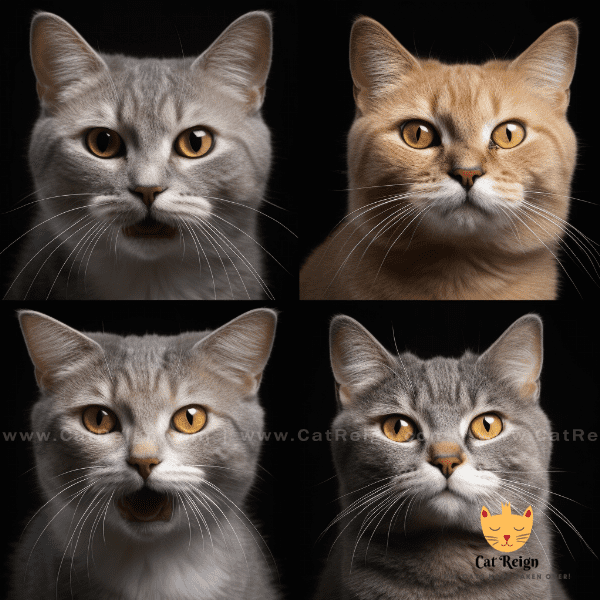
Vocalizations and What They Mean
In addition to body language, cats also use vocalizations to communicate with humans and other cats. In this section, we’ll explore some of the most common cat vocalizations and what they mean.
Meowing
Meowing is perhaps the most well-known cat vocalization. Cats meow for a variety of reasons, including to express hunger, to request attention, or simply to say hello. The tone and pitch of the meow can give you important clues as to what your cat is trying to communicate.
Purring
Purring is often associated with contentment and relaxation in cats. However, cats may also purr when they are feeling anxious or in pain, as purring can have a calming effect on the body.
Hissing
Hissing is a sign of fear or aggression in cats. If your cat is hissing, it’s important to give them space and avoid approaching them until they have calmed down.
Growling
Growling is another vocalization that cats use to communicate fear or aggression. If your cat is growling, it’s important to give them space and avoid provoking them.
Chirping
Chirping is a cute and endearing vocalization that some cats make when they are feeling happy or excited. It’s often a sign of playfulness and enjoyment.
By paying attention to your cat’s vocalizations, you can start to get a sense of what they are trying to communicate. However, it’s important to remember that every cat is unique, and some may have their own individual vocalizations and ways of communicating that you’ll need to learn to interpret over time.
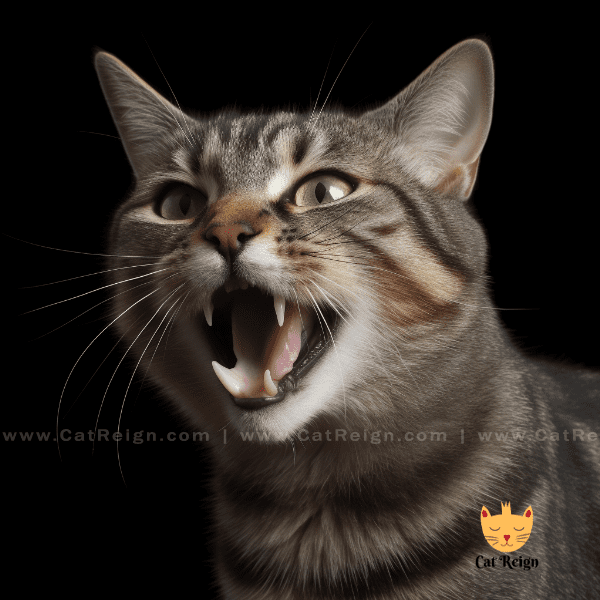
Communicating with Your Cat Using Body Language
Just as cats use body language to communicate with us, we can also use body language to communicate with them. In this section, we’ll explore some ways that you can use body language to communicate with your cat.
Eye Contact
Making eye contact with your cat can be a powerful way to communicate with them. If you want to show your cat affection, try slowly blinking at them, which is a sign of trust and relaxation in cat body language.
Body Posture
Your body posture can also send important signals to your cat. If you want to show your cat that you are relaxed and non-threatening, try sitting or crouching down, which can help make you appear smaller and less intimidating.
Touch
Touch is an important part of cat communication, and it can also be a powerful way to communicate with your cat. If you want to show your cat affection, try stroking their fur or gently scratching behind their ears.
Vocalizations
In addition to body language, you can also use vocalizations to communicate with your cat. Try talking to your cat in a calm, soothing voice to help reassure them and strengthen your bond.
Respect Your Cat’s Boundaries
It’s important to remember that cats are individuals, and they may not always want to be touched or interacted with. Always respect your cat’s boundaries and allow them to come to you on their own terms.
By using body language to communicate with your cat, you can strengthen your bond and build a deeper understanding of each other. However, it’s important to remember that every cat is unique, and what works for one cat may not work for another. Be patient and observant, and you’ll soon learn how to communicate effectively with your feline friend.
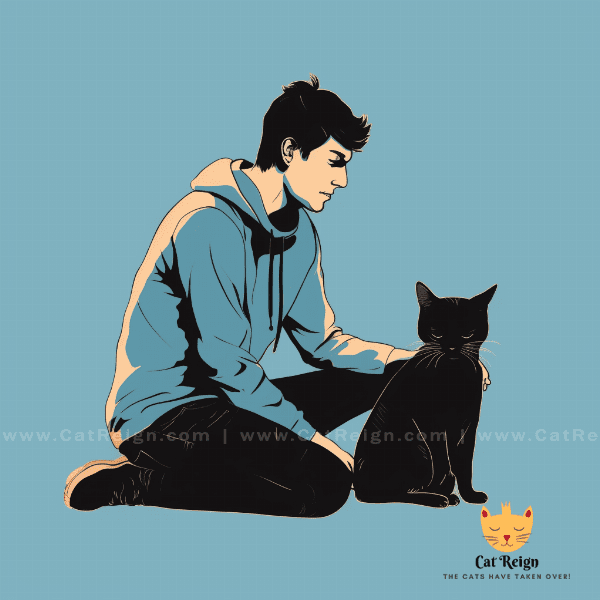
Misunderstandings and Common Cat Communication Errors
Despite our best efforts, misunderstandings can still occur between cats and humans. In this section, we’ll explore some of the most common cat communication errors and how to avoid them.
Misinterpreting Body Language
One of the most common communication errors is misinterpreting a cat’s body language. For example, a cat may be displaying aggressive behavior not because they are angry, but because they are feeling scared or threatened. To avoid this error, it’s important to observe your cat’s body language in context and try to understand what they are trying to communicate.
Misunderstanding Vocalizations
Cats use a range of vocalizations to communicate, but it can be difficult to understand what they are trying to say. To avoid misunderstanding your cat’s vocalizations, pay attention to the tone and pitch of their meows and try to interpret them in context.
Ignoring Boundaries
Cats are individuals and may have different preferences when it comes to socializing and interacting. It’s important to respect your cat’s boundaries and not force them to interact with you if they don’t want to.
Punishing or Yelling at Your Cat
Punishing or yelling at your cat is never an effective way to communicate with them. Cats respond much better to positive reinforcement and gentle encouragement.
Assuming Your Cat Understands You
Finally, it’s important to remember that cats don’t speak English (or any human language). While they may understand certain words and phrases, it’s important to communicate with them primarily through body language and vocalizations.
By avoiding these common cat communication errors, you can build a stronger and more positive relationship with your feline friend.
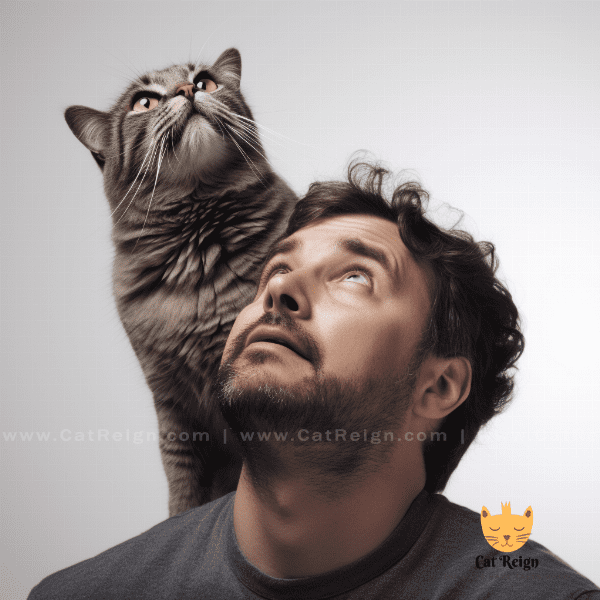
Tips for Strengthening Your Bond with Your Cat
Building a strong bond with your cat takes time and effort, but it’s also incredibly rewarding. In this section, we’ll explore some tips for strengthening your bond with your feline friend.
Spend Quality Time Together
One of the most important things you can do to strengthen your bond with your cat is to spend quality time together. This could mean playing with them, grooming them, or simply cuddling up with them on the couch.
Learn Their Preferences
Cats have their own individual preferences when it comes to play, food, and socializing. By learning what your cat likes and dislikes, you can tailor your interactions with them to better suit their needs.
Provide Enrichment
Cats are natural hunters and explorers, and providing them with enrichment activities can help keep them mentally and physically stimulated. This could mean providing them with puzzle toys or setting up a window perch for them to watch birds and other wildlife.
Use Positive Reinforcement
Positive reinforcement is a powerful tool for training and building a bond with your cat. When your cat does something that you like, such as using their scratching post instead of your furniture, reward them with praise or a treat.
Respect Their Boundaries
As we mentioned earlier, it’s important to respect your cat’s boundaries and not force them to interact with you if they don’t want to. By allowing your cat to come to you on their own terms, you can build trust and strengthen your bond over time.
By following these tips, you can build a strong and positive relationship with your cat that will last a lifetime. Remember to be patient, observant, and respectful of your cat’s needs, and you’ll soon find that you have a deep and meaningful connection with your feline friend.

Conclusion: Enhancing Communication with Your Feline Friend
Communicating with your cat using body language and vocalizations is an important part of building a strong and positive relationship with them. By understanding their body language, vocalizations, and individual preferences, you can better interpret what they are trying to communicate and respond in a way that strengthens your bond.
It’s important to remember that every cat is unique, and what works for one cat may not work for another. Be patient, observant, and respectful of your cat’s needs, and you’ll soon find that you have a deep and meaningful connection with your feline friend.
We hope that this guide has helped you better understand your cat’s body language and vocalizations, and that it has given you some practical tips for enhancing your communication with your feline friend. By following these tips, you can build a strong and lasting bond with your cat that will bring joy and happiness to both of your lives.
